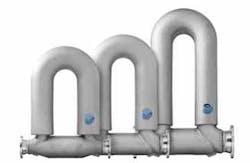Micro Motion is one of several manufacturers now offering high-capacity Coriolis flowmeters that aim to expand the technology segment’s support for line sizes over six inches. The meter pictured here is Micro Motion’s ELITE Capacity Coriolis, which supports line sizes from 8–10 inches.
Photo courtesy of Emerson Process Management, Micro Motion
Coriolis flowmeters were first introduced for commercial applications in 1977 by Micro Motion. Since then, they have become among the most sought-after types of flowmeters. Coriolis meters are valued for their accuracy, their reliability, and because they have no moving parts.
It is somewhat difficult to understand how Coriolis meters operate, partly because their vibrating tubes are invariably enclosed inside a protective outer lining. It is the vibrating tubes inside the meter that do the measuring.
For many years, all Coriolis flowmeters had bent-tube designs. Some have a single-tube design, while others have a dual-tube design. While these designs are very effective, given the Coriolis operating principles, they can create liquid buildup as the process fluid passes around the corners and crevices inside the flowtube. There are also some issues relating to pressure drop in bent tube meters.
To counteract the disadvantages of bent tube meters, some suppliers created straight-tube Coriolis meters. KROHNE was the first flowmeter company to introduce a commercially viable straight-tube meter in 1994. Straight-tube meters are well-suited for food & beverage and pharmaceutical applications since there is no buildup of the liquid from going around a bend. They also have virtually no pressure drop, which is another advantage.
While most straight-tube meters have a single tube, some also have dual-tube designs. Many straight-tube meters are made of titanium. Titanium is a light metal; yet it’s stronger than steel. Some suppliers have tried to make straight-tube meters applicable for gas applications, but so far they have mainly been successful only for liquid applications.
While Coriolis meters have many advantages, line size has always been a limitation. Due to their operating principle, Coriolis meters get unwieldy and expensive in sizes four inches and up. For many years, only Rheonik (now a part of GE Measurement & Control) made Coriolis meters in sizes above six inches. However, in the past several years, three more companies have entered the large line size Coriolis market. These include Micro Motion, KROHNE (www.krohne.com), and Endress+Hauser. These companies have produced Coriolis meters for line sizes from 8–16 inches. They are aimed at the fast-growing market for oil and gas flow measurement, including custody transfer.
Suppliers have not yet solved the problem of designing Coriolis meters for large line sizes that are small and compact. Many of these meters are as tall as a person, and are also very heavy. KROHNE has a straight-tube meter for large line sizes. While this meter is quite long, it is not as tall as a bent-tube design. These meters are also expensive, with some selling in the $75,000 range.
Despite the size and cost disadvantages of these large line size Coriolis meters, they have begun making their presence felt in the market. With crude oil selling in the range of $90 per barrel, and prices likely to increase in the long-term, some end-users are willing to pay the higher price of these Coriolis flowmeters.
Jesse Yoder, Ph.D., is president of Flow Research Inc. in Wakefield, Mass., a company he founded in 1998. He has 25 years of experience as an analyst and writer in process control. Dr. Yoder specializes in flowmeters and other field devices, including pressure and temperature products. Dr. Yoder can be reached at [email protected].
Flow Research recently published the latest update of its “Volume X: The World Market for Flowmeters,” highlighting trends in flow measurement worldwide. For details, visit FlowEverything.com.
About the Author
Jesse Yoder
Jesse Yoder, Ph.D., is president of Flow Research Inc. He has 30 years of experience as an analyst and writer in instrumentation. Yoder holds two U.S. patents on a dual-tube meter design and is the author of "The Tao of Measurement," published by ISA. He may be reached at [email protected]. Find more information on the latest study from Flow Research, "The World Market for Gas Flow Measurement, 4th Edition," at www.gasflows.com.

